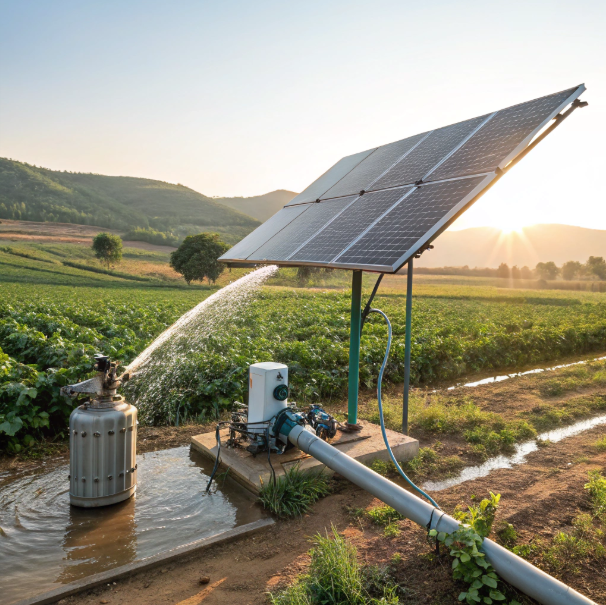Solar Water Pump User Guide: How to Get Started with Zero Experience?
by
Solar Water Pump User Guide: How to Get Started with Zero Experience?
Struggling with unreliable irrigation? Solar water pumps offer a sustainable, cost-effective solution—here’s how to set one up even if you’ve never touched a pump before.
Solar water pumps are beginner-friendly with basic components: solar panels, a pump, and a controller. Setup involves positioning panels, connecting parts, and adjusting flow—no prior expertise needed.
Ready to harness the sun’s power for your water needs? Let’s break down the process into simple, actionable steps.
Is installing a solar water pump complicated? Five steps to get it done and achieve automatic irrigation with ease!
Frustrated by complex machinery? Solar pumps simplify irrigation with minimal moving parts—here’s how to install yours in under a day.
Installation involves five steps: site assessment, mounting panels, connecting the pump, setting up the controller, and testing. Most systems come with plug-and-play components, requiring no technical skills.
Dive Deeper: Breaking Down the Installation
1. Site Assessment
- Sunlight Exposure: Panels need 6+ hours of direct sunlight. Use a solar pathfinder app to check shading.
- Water Source: Depth and distance from panels determine pump type (submersible vs. surface).
2. Mounting Solar Panels
- Angle: Tilt panels at your latitude’s angle for optimal output (e.g., 30° for 30°N).
- Location: Ground mounts are easier; roof mounts save space but require secure fastening.
| Component | Task | Tool Needed |
|---|---|---|
| Solar Panels | Secure to mount | Wrench set |
| Pump | Connect to panels/controller | Screwdriver |
3. Wiring and Controller Setup
- Controller: Prevents overloading by regulating voltage. Match wires color-to-color (red to red, black to black).
- Flow Adjustment: Use the controller dial to set water output (e.g., 5 liters/min for drip irrigation).
Pro Tip: Label wires during connection to avoid confusion later.
4. Testing and Troubleshooting
- Dry Runs: Switch on the system midday to check flow. No water? Verify all connections and pump priming.
- Maintenance: Clean panels monthly with water; inspect seals annually.
Myth Busting: Solar pumps don’t work on cloudy days.
False: Modern pumps store energy or use battery backups for consistent output.
With the global trend toward carbon neutrality, why have solar water pumps become a necessity in agriculture?
Watching fuel costs eat into profits? Solar pumps cut expenses and emissions—here’s why they’re the future of farming.
Solar pumps eliminate diesel/grid dependence, reducing operational costs by 60–70% while meeting carbon-neutral goals. Governments incentivize adoption with subsidies, making them essential for sustainable agriculture.
The Bigger Picture: Solar Pumps and Sustainability
1. Cost Savings
- Fuel-Free: A 5HP diesel pump costs ~$1,500/year in fuel; a solar equivalent uses free sunlight.
- Low Maintenance: Fewer parts mean fewer breakdowns (no engine oil changes or spark plugs).
2. Environmental Impact
- CO2 Reduction: One solar pump offsets ~1.5 tons of CO2 annually—equivalent to planting 40 trees.
- Water Conservation: Timers and sensors prevent over-irrigation, conserving groundwater.
| Factor | Diesel Pump | Solar Pump |
|---|---|---|
| Operating Cost | High ($0.30/L fuel) | $0 after installation |
| Lifespan | 5–7 years | 10+ years |
3. Policy Drivers
- Subsidies: India’s KUSUM scheme covers 60% of costs; similar programs exist in Africa/EU.
- Grid Independence: Remote farms bypass unreliable grids, ensuring uninterrupted irrigation.
Case Study: A Kenyan tea farm cut water costs by 80% after switching to solar, breaking even in 3 years.
24-hour stable water supply? The perfect solution: solar water pumps + energy storage systems.
Tired of nighttime water shortages? Pairing solar pumps with batteries ensures round-the-clock flow—here’s how it works.
Solar pumps with battery storage (or hybrid systems) store excess daytime energy for night use. Lithium-ion batteries offer 5–7 years of lifecycle, maintaining steady pressure without grid backup.
Beyond Daylight: Storage and Hybrid Solutions
1. Battery Storage
- Capacity: A 5kWh battery powers a 1HP pump for ~8 nighttime hours.
- Types: Lead-acid is cheaper; lithium-ion lasts longer (3,000+ cycles).
2. Hybrid Systems
- Grid/Solar Mix: Automatically switches to grid/battery when sunlight is low.
- Wind Combo: In windy areas, small turbines supplement solar input.
| Need | Solution | Cost Estimate |
|---|---|---|
| 24/7 Supply | Pump + 10kWh battery | $3,000–$5,000 |
| Backup for Clouds | Hybrid inverter | +$500 |
3. Smart Controllers
- IoT Integration: Apps like SolarEdge monitor usage and adjust flow remotely.
- Leak Alerts: Shut off pumps during pipe bursts to save water/energy.
Pro Tip: Size batteries at 2x daily usage to account for cloudy days.
Conclusion
Solar water pumps simplify irrigation, slash costs, and support sustainability—start small with a basic kit or scale up with storage for 24/7 water access.
Popular Posts
You may also be interested in:




